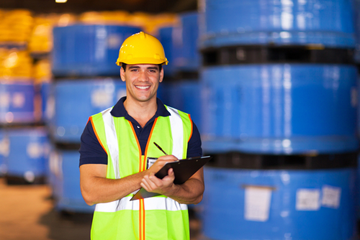10 Tips To Help Ensure Great Service While Safely Distributing Chemicals
 Booming industries put the pressure on for chemical distributors. Not only do you have to keep up with increasing demand, but you have to do so while ensuring customers that you’re taking all necessary safety precautions.
Booming industries put the pressure on for chemical distributors. Not only do you have to keep up with increasing demand, but you have to do so while ensuring customers that you’re taking all necessary safety precautions.
Check out these 10 tips for ensuring a safe work environment and a quality product.
1. Don’t skimp on labels. Every employee who walks through your facility should be able to identify chemicals on sight. Make it as easy as possible with clear, easily understood labels. As long as your labels are accurate, it’s hard to go overboard.
2. Prominently place MSDS. Material Safety Data Sheets (MSDS) contain crucial information for your chemical handlers, including storage instructions, specific dangers and tips for emergency response. Keep your MSDS forms with your chemicals so that employees don’t have to hunt for them. While you should also keep MSDS forms stored in a central location, that might not be enough if a worker has to make a split-second decision.
3. Post signs everywhere. At a glance, your employees should be able to safely navigate your facility while understanding what’s around them. Signage should indicate areas for safe storage, the dangers of chemicals in that area and direction for foot and vehicle travel within the facility. Don’t assume all employees can read English, either. Use multiple languages or symbols.
4. Use symbols. In the chemical industry, symbols can be your best friend. As long as staff members are familiar with them, they can identify chemical properties and dangers immediately. They also ensure that dangers and safety instructions are understood even when a language is not.
5. Keep your chemicals separated. Chemical storage requirements run the gamut. What’s safe for one drum might not be acceptable for another. What’s more, chemicals don’t always play nicely together. The best way to prevent unwanted reactions or interactions is to keep your chemicals a safe distance from each other.
6. Limit access when you can. Not all workers need free rein to come and go as they please. Your facility should limit access to certain areas to as few people as possible. Limits can be indicated by something as easy as floor tape or barriers, or they can be more robust and include fences and locks. Make sure all workers understand the security levels of every section of your facility.
7. Demand high standards in personal hygiene. Besides common courtesy, basic hygiene is important for keeping your chemical facility safe. Require employees to frequently wash their hands and to keep their work clothes clean. Don’t allow smoking near your facility — not only because of fire risk, but because of the potential of personal injury when chemical-ridden hands come in contact with the face. Contamination can happen on a very small scale yet have major safety implications down the line.
8. Never stop learning. That goes for you and your employees. Safety regulations change as we understand more about the chemicals we use. As such, make sure you are on top of industry news and best practices. Share that information with your staff, and require them to do refresher training from time to time. Don’t assume training from a decade ago will stick or remain relevant over time.
9. Audit yourself. Don’t wait for a safety inspector to identify safety issues. Find them yourself and fix them. Your proactive steps could make a world of difference in terms of keeping your products and employees safe.
10. Be prepared for the worst. If you can’t prevent all accidents from happening, at least you can contain them. Understand the risks, and know how to respond accordingly. Have simple instructions and emergency phone numbers posted throughout your facility. Keep medical supplies and fire extinguishers prominently stored. And have your employees practice safety drills, including evacuation in case of a chemical spill.
Chemical distribution is hazardous, but it doesn’t have to be impossibly dangerous. Take time to map out a thorough safety plan that goes above and beyond what is required. You’ll protect yourself from liability, and your diligence could actually save a life.
SolvChem is the largest independent chemical distributor in Texas — serving Texas, Louisiana, Arkansas, Oklahoma and Mississippi. A family-owned, minority-certified business founded in 1981, SolvChem delivers customized product and service solutions.












